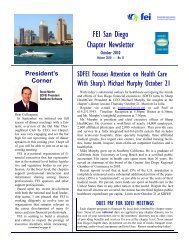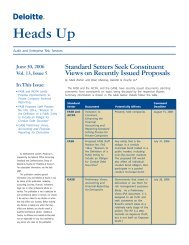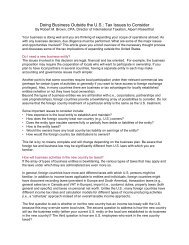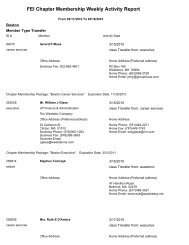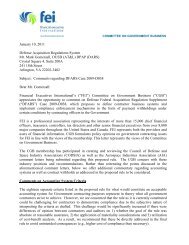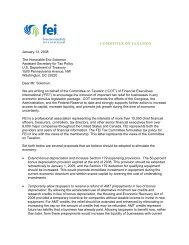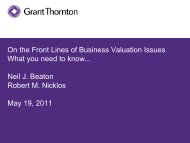Don't Get Grinched - Deloitte
Don't Get Grinched - Deloitte
Don't Get Grinched - Deloitte
You also want an ePaper? Increase the reach of your titles
YUMPU automatically turns print PDFs into web optimized ePapers that Google loves.
Retail<br />
Don’t <strong>Get</strong> <strong>Grinched</strong>:<br />
A Holiday<br />
Spending Outlook
The Wall Street grinches have borne not-so-glad tidings about the upcoming holiday shopping<br />
season. While consumer spending will be affected by current realities – falling home values, high<br />
gas prices, product recalls – the answer is not to close up the cash registers in resignation. An<br />
informed assessment of the current environment and of consumer trends can help retailers make<br />
sound business and planning decisions.<br />
For 22 years, <strong>Deloitte</strong> & Touche USA LLP has been monitoring<br />
consumer sentiment through an annual survey that gauges<br />
shoppers’ expectations and intentions for the holiday season<br />
and offers key fi ndings for retailers. Over the years, these<br />
results have allowed <strong>Deloitte</strong> to uncover and reconfi rm<br />
important consumer trends critical to retailers when developing<br />
strategies. From consumers’ expected spending changes<br />
due to economic events, to their use of online product/store<br />
reviews, their multi-channel preferences, and their choices<br />
around “green” buying, this year’s holiday survey results can<br />
help retailers better respond to today’s empowered consumers.<br />
One key fi nding from this year’s survey was that respondents<br />
were indeed being buffeted by various economic headwinds,<br />
and that spending on nonessential holiday goods and<br />
services would likely be curtailed. However, gift spending in<br />
particular was expected to be nearly even with last year’s level.<br />
Consumers expect to spend $569 on holiday gifts, compared<br />
with $584 in 2006. Households with lower incomes reported a<br />
sharper deterioration in spending from last year than did upper<br />
income households.<br />
The Federal Reserve’s recent rate cuts have eased marketplace<br />
hesitancy somewhat, but given the downturn in housing<br />
and higher gas/food prices, consumer spending growth this<br />
holiday period will likely be the lowest in several years. <strong>Deloitte</strong><br />
currently expects retail sales, excluding motor vehicles and<br />
gasoline, to increase in the 4.5% - 5% range this holiday<br />
season. This would be below the prior holiday period’s increase<br />
of 5.1%. Our expectations cover the months of November<br />
through January. We include January in the holiday period<br />
because of the strong growth in gift cards.<br />
The following is a look at some of the top economic issues that<br />
will impact consumer holiday spending, relevant survey fi ndings<br />
that discuss consumer sentiment and purchasing trends, and<br />
strategies retailers can employ in response. The bottom line is<br />
that while the season undoubtedly will be diffi cult for some,<br />
there are many steps that retailers can take to help improve the<br />
consumer’s desire to spend.<br />
The Positives for Holiday Spending<br />
Spending will likely not be characterized as robust this season,<br />
yet there are some positives in the economic backdrop that<br />
suggest that the selling environment could hold up for certain<br />
retailers. Importantly, consumers’ incomes have continued<br />
to increase, even after accounting for the effects of infl ation.<br />
Growth in income is perhaps the strongest indicator of the<br />
consumer’s ability to spend.<br />
Income growth is being helped by the fact that employers are<br />
continuing to hire, albeit at a slightly slower pace. Employment<br />
in October 2007 was up by 1.6 million workers from a year<br />
ago. Although this pace is down by about a million from<br />
mid-2006, it remains suffi cient to keep real (infl ation-adjusted)<br />
incomes buoyant. By year-end, higher gasoline prices could cut<br />
into growth prospects, but it is not yet clear how steep those<br />
price increases will be in the coming months.<br />
Figure 1. Growth in real disposable income has been healthy<br />
this year<br />
Year-over-year percent<br />
change in quarterly real<br />
disposable income<br />
6%<br />
4%<br />
2%<br />
0%<br />
2001<br />
Source: U.S. Commerce Department<br />
Average increase:<br />
2.7%<br />
2002 2003 2004 2005 2006 2007<br />
As used in this document, the term “<strong>Deloitte</strong>” includes <strong>Deloitte</strong> & Touche LLP, <strong>Deloitte</strong> Consulting LLP, <strong>Deloitte</strong> Tax LLP, and <strong>Deloitte</strong> Financial Advisory Services LLP<br />
1
Another positive is that consumers’ net worth continues to<br />
improve, even as housing prices ease. In the second quarter,<br />
net worth was 8% higher than it was a year ago, according<br />
to the Federal Reserve. Consumers’ real estate holdings were<br />
up a slight 4% for the year, but the value of their corporate<br />
equities and mutual fund shares were 11% higher and cash<br />
deposits had risen by 9%. Net worth likely did not grow<br />
as strongly in the third quarter, due in large part to the<br />
deterioration in the housing sector. The healthy growth in<br />
equity values, however, suggests that luxury goods retailers will<br />
see relatively good gains, although the increases may not be as<br />
strong as in previous years since “aspirational” luxury buyers<br />
will likely cut back somewhat. Ultra-luxury should continue to<br />
do well.<br />
The other bit of good news for holiday spending is that<br />
consumers who have responded to surveys have indicated that<br />
their holiday budgets will likely be impacted only minimally<br />
by the credit crunch and housing slump. A poll conducted by<br />
the International Council of Shopping Centers in mid-August<br />
found that only 18% of respondents were worried about the<br />
fi nancial turmoil and were “thinking twice” about spending.<br />
In late September, respondents to <strong>Deloitte</strong>’s holiday survey<br />
also showed low levels of concern in these areas. Only about<br />
one in ten felt that declining home values or higher mortgage<br />
payments would negatively impact their spending. In contrast,<br />
higher energy and food prices were the biggest concerns for<br />
respondents.<br />
The Negatives for Holiday Spending<br />
Look no further than the housing recession. Existing home<br />
sales have plummeted 30% from their 2005 peak, and the<br />
pace of new home sales has been cut almost in half, according<br />
to the National Association of Realtors and the US Census<br />
Bureau. The pullback in lending will continue to keep home<br />
sales subdued over the near term. Mortgage availability was<br />
reportedly improving in late October, but it will likely take until<br />
early 2008 before home sales benefi t.<br />
Housing-related issues are impacting consumers in other ways.<br />
In particular, decreased mortgage refi nancings are depleting<br />
that source of extra cash consumers had been relying on<br />
in recent years when they extracted cash from their home’s<br />
equity.<br />
Housing’s problems are beginning to fl ow through to other<br />
sectors of the economy. Construction employment is down,<br />
prices for home construction materials remain soft, and even<br />
the home remodeling industry is reporting weakening sales.<br />
More importantly, if fi nancial institutions continue with their<br />
stricter lending standards, corporate lending could soften,<br />
causing a pullback in hiring or investing in buildings and<br />
equipment. If capital spending weakens, other sectors of the<br />
economy will likely be impacted.<br />
Another concern for the economy is rising housing-related<br />
delinquency rates and foreclosures. Both are expected to<br />
continue to increase, in part because variable-rate mortgages<br />
are now being repriced at higher rates and taking a bigger<br />
chunk of consumers’ paychecks. While these percentages,<br />
relative to all mortgages outstanding, are quite small, they<br />
do represent a threat to spending, given the other negative<br />
headwinds.<br />
Figure 2. Mortgage payment problems are rising<br />
% of all<br />
mortgages that<br />
are delinquent<br />
5.6<br />
4.0<br />
Q2-2001<br />
Source: Mortgage Bankers Association<br />
2 As used in this document, the term “<strong>Deloitte</strong>” includes <strong>Deloitte</strong> & Touche LLP, <strong>Deloitte</strong> Consulting LLP, <strong>Deloitte</strong> Tax LLP, and <strong>Deloitte</strong> Financial Advisory Services LLP<br />
5.4<br />
5.2<br />
5.0<br />
4.8<br />
4.6<br />
4.4<br />
4.2<br />
% of all<br />
mortgages that<br />
are in foreclosure<br />
1.6<br />
Q2-2002 Q2-2003 Q2-2004 Q2-2005 Q2-2005 Q2-2007<br />
On the infl ation front, higher energy and food prices are<br />
cutting further into consumers’ spendable cash. As noted<br />
earlier in this report, these higher bills were the top reasons<br />
why consumers in our holiday survey felt they would be<br />
slowing their spending this year.<br />
The government’s infl ation data show that other sectors<br />
experiencing stronger pricing increases include medical care,<br />
educational books/supplies, tobacco and lodging. Retail<br />
sectors catering to lower-income households will likely be<br />
impacted more by these higher prices than will the luxury<br />
segment.<br />
Figure 3. Retail gasoline prices are headed back up<br />
Weekly price for<br />
regular, unleaded<br />
gasoline<br />
$3.50<br />
$3.30<br />
$3.10<br />
$2.90<br />
$2.70<br />
$2.50<br />
$2.30<br />
$2.10<br />
$1.90<br />
$1.70<br />
$1.50<br />
Source: U.S. Energy Department<br />
2005 2006 2007<br />
1.5<br />
1.4<br />
1.3<br />
1.2<br />
1.1<br />
1.0<br />
0.9<br />
0.8<br />
Nov. 5<br />
$3.01
What Retailers Can Do<br />
The less-than-cheerful tone of the holiday spending outlook<br />
should encourage retailers to assess consumer attitudes and<br />
trends carefully in order to select strategies that may support<br />
and strengthen sales efforts.<br />
Improve Customer Conversion<br />
Customer conversion tactics offer perhaps the best option for<br />
Web- and store-based retailers. There are ample opportunities<br />
to boost conversion by offering a better customer experience,<br />
either through improved staffi ng in the store, or by tweaking<br />
navigation and ordering on the Website.<br />
Conversion rates can also be increased through service<br />
improvements such as better merchandise organization, and<br />
informed, interactive sales personnel. A simple “How can I<br />
help you?” to store browsers can infl uence conversion even<br />
more than when the same is asked of destination shoppers.<br />
Additionally, a 2007 survey conducted by <strong>Deloitte</strong> & Touche<br />
USA LLP on conversion found that assistance in the dressing<br />
room strongly infl uenced conversion.<br />
Other factors that drive conversion include merchandise<br />
availability, improved store navigation and merchandise<br />
presentation, and a selling style that focuses on offering<br />
personal experiences, suggestions and testimonials. And<br />
thanks in part to the Internet, consumers are quick to spread<br />
the word about store experiences, both negative and positive.<br />
In the <strong>Deloitte</strong> holiday survey, one-third of respondents said<br />
they often read consumer-generated reviews of stores or<br />
products on the Internet. As these types of online activities<br />
continue to grow, retailers will benefi t by converting more<br />
shoppers into buyers and helping to create a longer-term<br />
affi nity with customers.<br />
Many of these conversion opportunities can be implemented<br />
in time for the holidays and involve only minimal costs, other<br />
than a reorientation of staff and a review of store/Website<br />
operations.<br />
Offer a Seamless Multi-Channel Experience<br />
E-commerce has altered the retail landscape and the ripple<br />
effect from the Internet on in-store sales continues to grow.<br />
Retailers are continuing to make their websites more userfriendly<br />
with features such as faster page loads, online chat<br />
capabilities, personalized information and easy ordering<br />
processes.<br />
In the <strong>Deloitte</strong> holiday survey, 63% of respondents said that<br />
they completed at least one type of multi-channel purchase<br />
over the past year. Nearly half, 46%, made an in-store<br />
purchase after viewing/researching the product on the retailer’s<br />
Website. One quarter purchased on the retailer’s Website after<br />
viewing the product in the store, and 16% purchased through<br />
the catalog after viewing the product on the retailer’s Website<br />
or in its store. As an overall comment about shopping, 48%<br />
said they liked the convenience of shopping with multi-channel<br />
retailers.<br />
To improve the seamless multi-channel experience for<br />
shoppers, retailers can better integrate their direct selling<br />
efforts (online, catalog, call center) with the in-store<br />
experience. Improved inventory visibility techniques, for<br />
example, are allowing retailers to view and reserve inventory<br />
across their consumer touchpoints. A shift as simple as<br />
implementing an in-store return policy can increase appeal<br />
to online shoppers. In a related area, newer media channels<br />
such as mobile marketing and the introduction of blogs on<br />
a retailer’s Website can improve customer interactions and<br />
purchases.<br />
In order to align channels throughout the enterprise,<br />
organizational structures, multi-channel accountability, and<br />
IT support need to be considered. Success in this area by the<br />
holiday season may be diffi cult, but improved coordination<br />
efforts between Websites and stores and the introduction of<br />
in-store returns can help grow sales.<br />
Tout the Corporation’s Sense of Responsibility and the<br />
Product’s Integrity<br />
Shoppers today are more emotionally involved with brands.<br />
Ethical retailing practices such as good-for-you products,<br />
worker conditions in overseas manufacturing plants, and<br />
environmentally-friendly operations are just a few of the topics<br />
that concern consumers.<br />
In <strong>Deloitte</strong>’s holiday survey results, 27% of consumers said<br />
they would be using fewer plastic bags this holiday season;<br />
18% would purchase more eco-friendly products, and 17%<br />
would seek out more “green” retailers. Further, 58% said that<br />
the recent news stories about product recalls would infl uence<br />
some of their purchase decisions this holiday season. The<br />
products that would be most closely monitored by consumers<br />
are toys and food.<br />
With product sourcing such a hot issue, retailers might want to<br />
let shoppers know that they sell “Made in the USA” products.<br />
Companies may also want to advertise planet-friendly practices<br />
such as energy-effi cient stores, green freight operations or the<br />
reduction of the retailer’s carbon footprint. Other options:<br />
Hook up with charities for certain sales events. Initiate more<br />
safety checks on the products sold. Create consumer-friendly<br />
labels or signage that let time-pressed consumers know about<br />
better-for-you benefi ts. Offer recyclable and minimal product<br />
packaging. The list is long and the benefi ts can be many.<br />
Make Gift Cards Easily Available for Shoppers – It’s Their<br />
#1 Gift Choice<br />
For four years running, gift cards have topped the list of what<br />
shoppers say they’ll be buying as presents. In 2007, 69% of<br />
respondents in <strong>Deloitte</strong>’s holiday survey said they’d be buying<br />
gift cards. They plan on buying 5.5 cards, on average, and<br />
spending a total of $199 on them. While overall holiday<br />
spending may be soft in 2007, this is one area that remains red<br />
hot with consumers, due mostly to the convenience aspect of<br />
the cards.<br />
As used in this document, the term “<strong>Deloitte</strong>” includes <strong>Deloitte</strong> & Touche LLP, <strong>Deloitte</strong> Consulting LLP, <strong>Deloitte</strong> Tax LLP, and <strong>Deloitte</strong> Financial Advisory Services LLP<br />
3
So why not make it easy for them to buy? Prominently display<br />
them. Promote them in communications to customers.<br />
Incorporate them into Websites, making them easy to<br />
purchase. Personalize them – some retailers are allowing<br />
purchasers to include voice messages or pictures. Others are<br />
providing additional incentives with the purchase of the card,<br />
such as “% off” promotions or free items. Package them with<br />
a small stuffed bear or a two-piece box of chocolates, to make<br />
them more appealing.<br />
Be creative about getting consumers to redeem those cards. In<br />
<strong>Deloitte</strong>’s holiday survey, consumers told us they were walking<br />
around with nearly two unused gift cards in their wallets, on<br />
average. Eight percent had fi ve or more unused cards. Since<br />
gift card redeemers typically spend more than the face value<br />
of the card, it’s to the retailer’s benefi t to get those cards out<br />
of shoppers’ wallets. At a minimum, make sure the stores are<br />
stocked with fresh merchandise starting December 26 to entice<br />
recipients into buying.<br />
Gift card redemption is particularly important to retailers<br />
because, from an accounting perspective, revenue can’t<br />
be recognized on the fi nancial statements until the card is<br />
redeemed. This is an issue for many retailers, particularly<br />
since a 2006 <strong>Deloitte</strong> consumer survey found that 18% of<br />
respondents owned at least one card that was more than two<br />
years old.<br />
Protect Customers’ Data – and Assure Them That It’s<br />
Being Done<br />
Identity theft is the fastest growing crime in the US according<br />
to the FBI. More than ever, retailers today are vulnerable to<br />
inappropriate exposure or outright loss of data, and, importantly,<br />
loss of customer trust and damage to brand reputation. Nearly<br />
one in fi ve respondents to our holiday survey said they had<br />
changed their shopping behaviour because of concerns around<br />
identity theft. Two-thirds of those said they no longer give out<br />
personal information to store employees as easily as they used to.<br />
The key for retailers in minimizing the destructive impact<br />
from identity theft is to be proactive. When a security breach<br />
does occur, an established, strategic response plan will<br />
enhance a retailer’s ability to respond. Relative to operations,<br />
departments that store credit card and other shopper/loyalty<br />
card information require close monitoring. Point-of-sale<br />
systems need to be examined, along with the expanding<br />
Internet channel. As consumer awareness of identity theft<br />
grows, an appropriate privacy protection program can allow a<br />
retailer to gain a sustainable, differentiated advantage in the<br />
marketplace.<br />
Make Sure You <strong>Get</strong> All That’s Coming to You<br />
We’re talking about optimizing the corporation’s tax position,<br />
especially with regard to certain tax credits and incentives<br />
that may lower the retailer’s tax bill. For example, there are<br />
“green” tax incentives that can benefi t companies that have<br />
adopted environmentally-friendly business practices. Incentives<br />
are often available at both the federal and state levels.<br />
Tax credits for training, proper accounting for vendor<br />
allowances, gift card revenue deferrals and tax-effi cient import<br />
strategies are additional ways that companies can unlock<br />
potentially sizeable tax savings opportunities.<br />
The bottom line is that retailers have at their disposal a myriad<br />
of marketing, operational and pricing strategies to respond to<br />
any Grinch-like behavior from consumers. As happened to the<br />
Grinch, behaviors can be coaxed into changing.<br />
About the Survey<br />
The holiday survey was commissioned by <strong>Deloitte</strong> & Touche<br />
USA LLP and conducted online by an independent research<br />
company between September 24 and October 4, 2007. The<br />
survey polled a sample of 14,135 consumers and has a margin<br />
of error for the entire sample of plus or minus one percentage<br />
point.<br />
4 As used in this document, the term “<strong>Deloitte</strong>” includes <strong>Deloitte</strong> & Touche LLP, <strong>Deloitte</strong> Consulting LLP, <strong>Deloitte</strong> Tax LLP, and <strong>Deloitte</strong> Financial Advisory Services LLP
Authors<br />
Stacy Janiak<br />
Vice Chairman & U.S. Retail Leader<br />
<strong>Deloitte</strong> & Touche USA LLP<br />
Tel: 612.397.4235<br />
Email: sjaniak@deloitte.com<br />
Diane Kutyla<br />
Economist<br />
<strong>Deloitte</strong> Services LP<br />
Tel: 973.683.7885<br />
Email: dkutyla@deloitte.com<br />
For More Information<br />
For more information about <strong>Deloitte</strong> & Touche USA LLP’s Retail Practice, contact:<br />
Stacy Janiak<br />
Vice Chairman & U.S. Retail Leader<br />
<strong>Deloitte</strong> & Touche USA LLP<br />
Tel: 612.397.4235<br />
Email: sjaniak@deloitte.com<br />
John Scheffler<br />
U.S. Assurance Leader, Retail<br />
<strong>Deloitte</strong> & Touche LLP<br />
Tel: 415.783.6827<br />
Email: jscheffl er@deloitte.com<br />
Ed Spangler<br />
U.S. Consulting Leader, Retail<br />
<strong>Deloitte</strong> Consulting LLP<br />
Tel: 312.486.2132<br />
Email: espangler@deloitte.com<br />
Nancy Wertheim<br />
U.S. Tax Leader, Retail<br />
<strong>Deloitte</strong> Tax LLP<br />
Tel: 617.437.2722<br />
Email: nwertheim@deloitte.com<br />
Retail Growth Challenge Framework Series<br />
The Retail practice of <strong>Deloitte</strong> & Touche USA LLP is proud to produce a unique<br />
eight-part series about key issues that retailers should be thinking about now to<br />
achieve sustained, profi table growth in the years ahead. To help retailers adapt their<br />
competitive strategies and put a new transformative growth model to work, <strong>Deloitte</strong><br />
created its Retail Growth Challenge Framework, a series of forward-thinking articles<br />
that focus on customer conversion, the changing customer, growth strategies, cost<br />
reduction, the multi-channel brand experience, and precision retailing. Together,<br />
these reports span all levels of management activity—strategic, administrative, and<br />
operational—to ensure that the right resources, organization, processes, and culture<br />
are in place to embrace new growth initiatives and meet existing growth objectives.<br />
To access these articles, visit www.deloitte.com/us/RetailGrowthSeries.<br />
Visit <strong>Deloitte</strong>.com<br />
To learn more about our practice, visit us online at www.deloitte.com/us/Retail. Here<br />
you can access our complimentary Dbriefs webcast series, <strong>Deloitte</strong> Insights podcast<br />
program, innovative and practical industry research, and a lot more about the issues<br />
facing consumer businesses from some of the industry’s most experienced minds.<br />
Lawrence Hutter<br />
Global Industry Managing Partner<br />
<strong>Deloitte</strong> Touche Tohmatsu<br />
Tel: +44.20.7303.8648<br />
Email: lhutter@deloitte.com<br />
Sandra Viola<br />
U.S. Director of Marketing<br />
<strong>Deloitte</strong> Services LP<br />
Tel: 212.436.3058<br />
Email: sviola@deloitte.com<br />
As used in this document, the term “<strong>Deloitte</strong>” includes <strong>Deloitte</strong> & Touche LLP, <strong>Deloitte</strong> Consulting LLP, <strong>Deloitte</strong> Tax LLP, and <strong>Deloitte</strong> Financial Advisory Services LLP<br />
5
About <strong>Deloitte</strong><br />
<strong>Deloitte</strong> refers to one or more of <strong>Deloitte</strong> Touche Tohmatsu, a Swiss Verein, its member fi rms and their respective subsidiaries and affi liates. <strong>Deloitte</strong> Touche<br />
Tohmatsu is an organization of member fi rms around the world devoted to excellence in providing professional services and advice, focused on client<br />
service through a global strategy executed locally in nearly 140 countries. With access to the deep intellectual capital of approximately 150,000 people<br />
worldwide, <strong>Deloitte</strong> delivers services in four professional areas — audit, tax, consulting, and fi nancial advisory services — and serves more than 80 percent<br />
of the world’s largest companies, as well as large national enterprises, public institutions, locally important clients, and successful, fast-growing global<br />
companies. Services are not provided by the <strong>Deloitte</strong> Touche Tohmatsu Verein, and, for regulatory and other reasons, certain member fi rms do not provide<br />
services in all four professional areas.<br />
As a Swiss Verein (association), neither <strong>Deloitte</strong> Touche Tohmatsu nor any of its member fi rms has any liability for each other’s acts or omissions. Each of<br />
the member fi rms is a separate and independent legal entity operating under the names “<strong>Deloitte</strong>,” “<strong>Deloitte</strong> & Touche,” “<strong>Deloitte</strong> Touche Tohmatsu,” or<br />
other related names.<br />
In the United States, <strong>Deloitte</strong> & Touche USA LLP is the U.S. member fi rm of <strong>Deloitte</strong> Touche Tohmatsu and services are provided by the subsidiaries of<br />
<strong>Deloitte</strong> & Touche USA LLP (<strong>Deloitte</strong> & Touche LLP, <strong>Deloitte</strong> Consulting LLP, <strong>Deloitte</strong> Financial Advisory Services LLP, <strong>Deloitte</strong> Tax LLP, and their subsidiaries),<br />
and not by <strong>Deloitte</strong> & Touche USA LLP. The subsidiaries of the U.S. member fi rm are among the nation’s leading professional services fi rms, providing audit,<br />
tax, consulting, and fi nancial advisory services through nearly 40,000 people in more than 90 cities. Known as employers of choice for innovative human<br />
resources programs, they are dedicated to helping their clients and their people excel. For more information, please visit the U.S. member fi rm’s Web site at<br />
www.deloitte.com<br />
Copyright © 2007 <strong>Deloitte</strong> Development LLC. All rights reserved.<br />
Member of<br />
<strong>Deloitte</strong> Touche Tohmatsu



